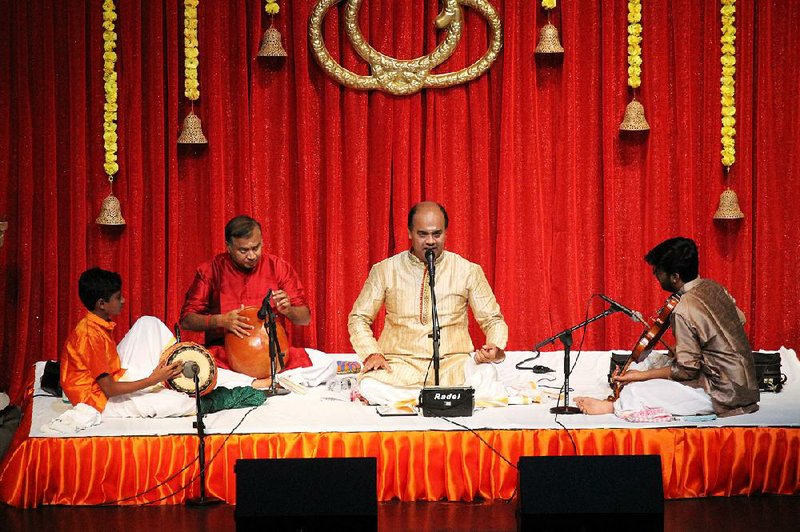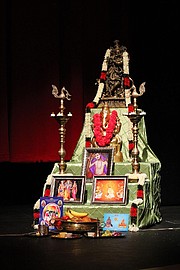The occasional pair of shoulders could be seen swaying among the hundreds gathered in the audience, as heads nodded and feet tapped to the rhythm of percussion and vocals of the Indian classical art form known as Carnatic music.
At the head of the Maumelle High School auditorium, four musicians -- seated on a platform with legs folded beneath them -- performed the classical music unique to southern India, with vocals and instruments blending in the songs that are part of a Hindu tradition that stretches back centuries.
Renowned musicians -- vocalist Delhi Sunderrajan, violinist Vignesh Thyagarajan and ghatam player Adambakkam Shankar -- were assembled onstage, but the evening had been arranged for the youngest of the group, 11-year-old Siddharth Sridharan.
Siddharth, a sixth-grade student at LISA Academy Chenal in Little Rock, also was onstage, playing a double-headed percussion instrument known as the mridangam. Years of training and practice culminated in his debut performance, known in Indian culture as the arangetram -- the first such instrumental performance in central Arkansas.
Sunderrajan, vocalist for the Sept. 7 performance, said there is no clear evidence as to when the larger Indian classical music genre developed into the two subtypes known today as Carnatic and Hindustani, the latter of which is associated with northern India. Both have their origins in the Vedas, which are among the oldest religious texts of Hinduism.
"It's kind of like the equivalent of the West listening to Handel's Messiah," said Dr. Rolf Groesbeck, a professor of music history, musicology and ethnomusicology at the University of Arkansas at Little Rock. "A lot of people in this country may not know classical music, but most people have been to a church where they hear Handel's Messiah, [and] this is the same thing ... they recognize some of the hymns from their temples and because of that I think the music has an accessibility to a general audience."
It's also an improvised style of music akin to jazz, said Thyagarajan, a student at San Jose State University in California; and Sunderrajan and Shankar's nephew.
"You have all these musicians being able to get together at one time despite having different schedules," Thyagarajan said. "Being in different places at different times, they can easily get together and perform onstage due to the improvisational aspects of the music ... it has a certain devotional context or meaning, and on top of that, we improvise."
The vocabulary involved in the Carnatic tradition are rich in etymological significance. The word Carnatic is derived from the Sanskrit word "Karnataka," with one meaning interpreted as "that which is sweet or pleasing to the ear." The mridangam -- itself of ancient origin -- is an accompanying instrument common in Carnatic music and is a union of the Sanskrit words for "clay" and "body."
According to the 2014 Pew Research Religious Landscape Study, less than 1% of Arkansans are Hindu, but the Indian community has grown over the past four decades to more than 2,000 members, many of whom are adherents to Hinduism. Construction on a temple in Little Rock has been underway for the past year and is slated for completion later this year, said Viji Sridharan, a research instructor at the University of Arkansas for Medical Sciences.
GAINING GROUND
The arangetram honors Indian culture and Hindu faith through its tradition and devotional lyrics, and it's a concert form that's gaining ground in California and on the East Coast, said Thyagarajan, places where larger numbers of tech, business, engineering and medical careers are available.
Festivals held in states including New Jersey, North Carolina, Texas and Ohio have brought the music around for a new generation to appreciate. And while arangetrams have been held in central Arkansas for performances of the devotional dance style known as Bharatanatyam, Siddharth Sridharan's arangetram is the first to be devoted to demonstrating a level of mastery of a musical instrument.
Siddharth began mridangam lessons at age 5 after expressing an early interest in Carnatic music. He is a shishya, or disciple, of Neyveli Narayanan, a sought-after musician and guru known as a vidwan, or an expert in the field. Although Narayanan has passed on most of his instruction through weekly Skype sessions, he has stopped by for lessons when traveling in the states. Sridharan also spent seven weeks learning from Narayanan during the recent summer in India where the guru resides, receiving one-on-one training.
Arangetram literally means "ascend the stage," and Sunderrajan explained the parameters involved in deciding when the time is right for a student to make his or her debut.
"There is a particular stage where the guru feels that [a student] has reached a level where he can be presented onstage in front of such a big gathering," Sunderrajan said of the arangetram. "It's like a fusion of all the knowledge learned and all the hard work he has been doing, and the knowledge imparted by the guru -- everything has reached a stage today ... that he can [play] onstage in the company of other musicians."
Sridharan had a simple explanation for the source of his inspiration to learn the mridangam: His dad.
"[His father] is [Siddharth's] most inspiration," said his mother, Viji Sridharan. "He has seen his father play [the mridangam].
"It's more than me," said Siddharth's father, Sridharan Soundararajan. "All the time he used to listen to classical music -- at home, when we traveled in the car."
"At home, we both love Carnatic music, so it's only that [music] we play," Viji Sridharan said.
MARATHON, NOT A SPRINT
The arangetram is a display of range and ability but also one of endurance, and Siddharth's debut fell within the traditional two- to three-hour time frame.
Onstage, his expression one of calm composure, the disciple performed with the three vidwans -- Sunderrajan, Thyagarajan and Adambakkan -- all taking occasional sips of water or Gatorade between compositions and wiping perspiration from their faces, which were warmed from the stage lighting above.
After the performance, in tradition, Narayanan and others involved in the arangetram and the years preceding it were warmly welcomed onstage to congratulate the musicians, give gifts and praise the newest mridangist in central Arkansas.
Rajesh Chokhani, chief operating officer of Welspun Tubular and a guest of honor at the debut, called Siddharth's performance fantastic and magical, evoking laughter at the expression that he would have gladly "been on the stage by now and dancing [to] these beats.
"Siddharth, you have no idea what you have done today," Chokhani continued. "In today's time, when parents are struggling to take away the electronic devices from their kids ... you have shown so much interest and enthusiasm and completed this course today ... so the heartiest congratulations to you."
'ENJOYED BY ANYONE'
Sangeeta Khare of Little Rock, one of the guests at the Sept. 7 performance, said her daughter's dance arangetram was held in Texas.
"It can be enjoyed by anyone," Khare said of the arangetram. "It's about your talent, and it also allowed my daughter to grow the attachment with her heritage."
Srinivasan Jeyvel of Little Rock came to the arangetram with his young son, one of many parents who shared in the experience of watching the arangetram with their children.
"It's an achievement for [Siddharth] to play this musical instrument in front of an audience," Jeyvel said.
Groesbeck hosted the musicians at a presentation for one of his classes earlier in the week, which he said was received with enthusiasm and interest. He recalled in years past performing on a drum comparable to the mridangam.
"I had my own arangetram, but that was when I was 32, and to me that seemed like about the right time," Groesbeck said before the performance. "So for an 11-year-old to do this, I can't even imagine.
"I guess the lesson of today is that if you work really hard enough at something, you have a chance to achieve great things that many people would not think possible."
Religion on 09/14/2019

